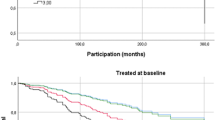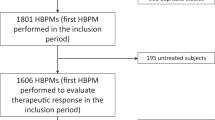Abstract
The prognostic value of ambulatory blood pressure (BP) monitoring for long-term prognosis varies in recent studies. The study aimed to investigate the role of ambulatory BP parameters in mortality and cardiovascular (CV) events in hypertensive patients. A series of 412 participants (59.3±4.0 years) who received ambulatory BP monitoring for their fluctuated BP, either untreated or treated since 1995, were enroled. The mortality and CV events were obtained by follow-up and linked to the National Death Registry in Taiwan. There were 233 untreated and 179 treated patients. The latter were older with more comorbidity when compared with the former. After follow-up for 8.5±1.7 years, both ambulatory systolic BP and pulse pressure (PP) could predict all-cause mortality, non-CV mortality, CV disease and stroke after adjusting for baseline covariates. However, only ambulatory PP could predict CV mortality and coronary heart disease. Ambulatory PP is better than ambulatory systolic BP, particularly in prediction of all-cause mortality. There was no predictive value of office BP in any outcome. In conclusion, ambulatory PP is a good predictor for long-term outcomes in hypertensive patients. The parameters of ambulatory rather than office BP could be applied for risk stratification either before or under antihypertensive treatment.
This is a preview of subscription content, access via your institution
Access options
Subscribe to this journal
Receive 12 digital issues and online access to articles
$119.00 per year
only $9.92 per issue
Buy this article
- Purchase on Springer Link
- Instant access to full article PDF
Prices may be subject to local taxes which are calculated during checkout
Similar content being viewed by others
References
Lewington S, Clarke R, Qizilbash N, Peto R, Collins R, Prospective Studies Collaboration. Age-specific relevance of usual blood pressure to vascular mortality: a meta-analysis of individual data for one million adults in 61 prospective studies. Lancet 2002; 360: 1903–1913.
Pickering TG, Hall JE, Appel LJ, Falkner BE, Graves J, Hill MN, et al., Subcommittee of Professional and Public Education of the American Heart Association Council on High Blood Pressure Research. Recommendations for blood pressure measurement in humans and experimental animals: Part 1: blood pressure measurement in humans: a statement for professionals from the Subcommittee of Professional and Public Education of the American Heart Association Council on High Blood Pressure Research. Hypertension 2005; 45: 142–161.
Clement DL, De Buyzere ML, De Bacquer DA, de Leeuw PW, Duprez DA, Fagard RH, et al., Office versus Ambulatory Pressure Study Investigators. Prognostic value of ambulatory blood-pressure recordings in patients with treated hypertension. N Engl J Med 2003; 348: 2407–2415.
Dolan E, Stanton A, Thijs L, Hinedi K, Atkins N, McClory S et al. Superiority of ambulatory over clinic blood pressure measurement in predicting mortality: the Dublin outcome study. Hypertension 2005; 46: 156–161.
Kikuya M, Ohkubo T, Asayama K, Metoki H, Obara T, Saito S et al. Ambulatory blood pressure and 10-year risk of cardiovascular and noncardiovascular mortality: the Ohasama study. Hypertension 2005; 45: 240–245.
Sega R, Facchetti R, Bombelli M, Cesana G, Corrao G, Grassi G et al. Prognostic value of ambulatory and home blood pressures compared with office blood pressure in the general population: follow-up results from the Pressioni Arteriose Monitorate e Loro Associazioni (PAMELA) study. Circulation 2005; 111: 1777–1783.
Conen D, Bamberg F . Noninvasive 24-h ambulatory blood pressure and cardiovascular disease: a systematic review and meta-analysis. J Hypertens 2008; 26: 1290–1299.
Boggia J, Li Y, Thijs L, Hansen TW, Kikuya M, Björklund-Bodegård K, et al., International Database on Ambulatory Blood Pressure Monitoring in Relation to Cardiovascular Outcomes (IDACO) Investigators. Prognostic accuracy of day versus night ambulatory blood pressure: a cohort study. Lancet 2007; 370: 1219–1229.
Yang HC, Liang YJ, Wu YL, Chung CM, Chiang KM, Ho HY et al. Genome-wide association study of young-onset hypertension in the Han Chinese population of Taiwan. PLoS One 2009; 4: e5459.
American Diabetes Association. Diagnosis and classification of diabetes mellitus. Diabetes Care 2004; 27 (Suppl 1): S5–S10.
National Cholesterol Education Program (NCEP) Expert Panel on Detection, Evaluation, and Treatment of High Blood Cholesterol in Adults (Adult Treatment Panel III). Third Report of the National Cholesterol Education Program (NCEP) Expert Panel on Detection, Evaluation, and Treatment of High Blood Cholesterol in Adults (Adult Treatment Panel III) final report. Circulation 2002; 106: 3143–3421.
O'Brien E, Mee F, Atkins N . An accurate automated device for home blood pressure measurement at last! The Omron HEM-705C. J Hypertens 1994; 12: 1317–1318.
O'Brien E, Mee F, Atkins N, O'Malley K . Accuracy of the SpaceLabs 90207 determined by the British Hypertension Society protocol. J Hypertens 1991; 9: 573–574.
Lu TH, Lee MC, Chou MC . Accuracy of cause-of-death coding in Taiwan: types of miscoding and effects on mortality statistics. Int J Epidemiol 2000; 29: 336–343.
Perloff D, Sokolow M, Cowan R . The prognostic value of ambulatory blood pressures. JAMA 1983; 249: 2792–2798.
Staessen JA, Thijs L, Fagard R, O'Brien ET, Clement D, de Leeuw PW et al. Predicting cardiovascular risk using conventional vs ambulatory blood pressure in older patients with systolic hypertension. Systolic Hypertension in Europe Trial Investigators. JAMA 1999; 282: 539–546.
Franklin SS, Khan SA, Wong ND, Larson MG, Levy D . Is pulse pressure useful in predicting risk for coronary heart Disease? The Framingham heart study. Circulation 1999; 100: 354–360.
Staessen JA, Thijs L, O'Brien ET, Bulpitt CJ, de Leeuw PW, Fagard RH et al. Syst-Eur Trial Investigators. Ambulatory pulse pressure as predictor of outcome in older patients with systolic hypertension. Am J Hypertens 2002; 15: 835–843.
Miura K, Dyer AR, Greenland P, Daviglus ML, Hill M, Liu K, et al., Chicago Heart Association. Pulse pressure compared with other blood pressure indexes in the prediction of 25-year cardiovascular and all-cause mortality rates: the Chicago Heart Association Detection Project in Industry Study. Hypertension 2001; 38: 232–237.
Lawes CM, Bennett DA, Parag V, Woodward M, Whitlock G, Lam TH, et al., Asia Pacific Cohort Studies Collaboration. Blood pressure indices and cardiovascular disease in the Asia Pacific region: a pooled analysis. Hypertension 2003; 42: 69–75.
Pastor-Barriuso R, Banegas JR, Damián J, Appel LJ, Guallar E . Systolic blood pressure, diastolic blood pressure, and pulse pressure: an evaluation of their joint effect on mortality. Ann Intern Med 2003; 139: 731–739.
Hansen TW, Kikuya M, Thijs L, Björklund-Bodegård K, Kuznetsova T, Ohkubo T, et al., IDACO Investigators. Prognostic superiority of daytime ambulatory over conventional blood pressure in four populations: a meta-analysis of 7030 individuals. J Hypertens 2007; 25: 1554–1564.
Inoue R, Ohkubo T, Kikuya M, Metoki H, Asayama K, Obara T et al. Predicting stroke using 4 ambulatory blood pressure monitoring-derived blood pressure indices: the Ohasama Study. Hypertension 2006; 48: 877–882.
Fagard RH, Thijs L, Staessen JA, Clement DL, De Buyzere ML, De Bacquer DA . Prognostic significance of ambulatory blood pressure in hypertensive patients with history of cardiovascular disease. Blood Press Monit 2008; 13: 325–332.
Eguchi K, Pickering TG, Hoshide S, Ishikawa J, Ishikawa S, Schwartz JE et al. Ambulatory blood pressure is a better marker than clinic blood pressure in predicting cardiovascular events in patients with/without type 2 diabetes. Am J Hypertens 2008; 21: 443–450.
Pan WH, Yeh WT, Chang HY, Hwu CM, Ho LT . Prevalence and awareness of diabetes and mean fasting glucose by age, sex, and region: results from the Nutrition and Health Survey in Taiwan, 1993–1996. Diabet Med 2003; 20: 182–185.
Acknowledgements
This work was supported by grants including V95A-011, V97C1-125 and V98A-015 from the Taipei Veterans General Hospital, Taiwan, ROC.
Author information
Authors and Affiliations
Corresponding author
Ethics declarations
Competing interests
The authors declare no conflict of interest.
Rights and permissions
About this article
Cite this article
Kao, YT., Huang, CC., Leu, HB. et al. Ambulatory pulse pressure as a novel predictor for long-term prognosis in essential hypertensive patients. J Hum Hypertens 25, 444–450 (2011). https://doi.org/10.1038/jhh.2010.80
Received:
Revised:
Accepted:
Published:
Issue Date:
DOI: https://doi.org/10.1038/jhh.2010.80
Keywords
This article is cited by
-
Pulse pressure as an independent predictor of stroke: a systematic review and a meta-analysis
Clinical Research in Cardiology (2016)
-
Ambulatory Blood Pressure Monitoring in the Prediction and Prevention of Coronary Heart Disease
Current Hypertension Reports (2013)



